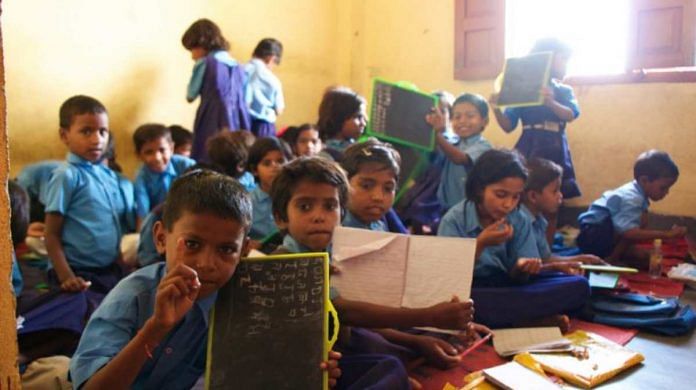New Delhi: Schools in Delhi have extremely high concentrations of harmful air pollutants like PM 2.5, PM 10 and carbon dioxide, much higher than the permissible limits recommended by the World Health Organization, a new study has found.
According to the study, conducted by the Centre of Excellence for Research on Clean Air (CERCA), IIT Delhi and the Society for Indoor Environment, the concentrations of these pollutants within school premises were 12-15 times higher than the WHO’s permissible standards of about 20 μg/m.
It further noted that the concentration of these pollutants peaked during recess time (12-2 pm) and at night.
The researchers said these pollutants were found in such high quantities in schools because of the constant use of chalk and duster and poor ventilation on these premises. The dust emitted from the use of chalks and dusters contributes to increased PM 2.5 and 10 levels that have nowhere to escape.
They also found that the total volatile organic compounds (TVOC) — compounds present in ambient air or emissions — levels were higher in schools due to construction activities. The CO2 levels in some of the schools also exceeded normal standards, which was attributed to poor ventilation and immediate environment.
The study, titled Project MAQUID (Monitoring of Air Quality in Urban Indoors in Delhi), was conducted between 15 October 2019 and 30 January 2020, when air pollution was at its peak in the national capital. The study was conducted across 37 important public indoor spaces including six schools, six colleges, six malls, six offices, six restaurants, six hospitals and a cinema hall.
At the launch of the study Friday, Professor Arun Sharma, president of the Society for Indoor Environment, said: “We tried to include as much geographical area as possible, including the trans-Yamuna area and the borders of Delhi. This was to ensure that a sample is taken from all kinds of areas with different factors influencing the air quality.”
Officials at IIT Delhi told ThePrint the study results couldn’t be published earlier because of the pandemic as data analysis couldn’t be done during the lockdown.
Also read: Global warming likely to rise to 3 degrees Celsius by 2100, well above Paris accord target — UN
Other locations
Colleges followed schools in terms of bad indoor air quality with PM 2.5 and PM 10 levels approximately 10-15 times higher than WHO standards. This was primarily due to the proximity to main roads and activities like cooking and smoking on campus.
Restaurants were also found to have high TVOC levels due to the cleaning of tables and floor with chemicals.
Meanwhile, all offices also had PM 2.5 and PM 10 levels exceeding permissible limits. This was due to proximity to main roads. High occupancy and poor ventilation also contributed to high Co2 concentration.
According to Sharma, even hospitals did not have clean indoor air.
“Hospitals are supposed to be cleaner than all other buildings but we found high PM concentration there too. Surprisingly, smoking around hospitals was a major air pollutant,” he said.
The carbon dioxide levels in hospitals were also very high since patients and doctors are always present in the premises. It was worse in winters because buildings are closed instead of installing central heating systems.
The researchers stated that shopping malls had the cleanest indoor air among all public spaces surveilled, because of the size of the buildings and efficient functioning of central heating, ventilation and air conditioning systems.
Also read: Toxic smog that reduces lifespan to persist in India till March — climate change service
Recommendations of the study
According to the study, the findings are extremely concerning.
“It is worrying that the air quality indoors is worse than that outside. Keeping this in mind it is essential that builders of public buildings consider ventilation as an important factor for the well being of individuals present inside,” the study noted.
It also recommended that setting up air sensors displaying the indoor air quality vis-a-vis the ambient air quality should be made mandatory.
Another important recommendation was the establishment of national standards for indoor air quality.
Also read: India’s use of coal power may have peaked in 2018, report says



